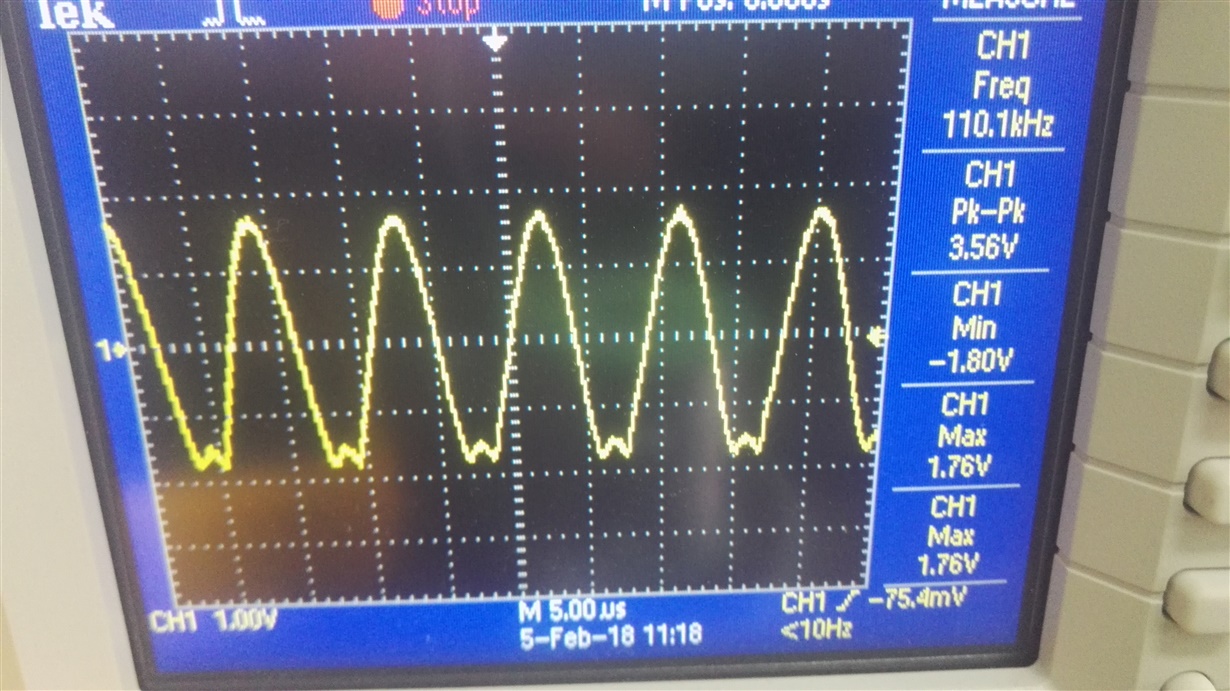Other Parts Discussed in Thread: PGA204
HI,dear:
I made a circuit with PGA103, however, the signal is cut off as pictures. The input is sine and the amplitude is 40mv PK-PK, the power is ±5V. why the output is cut off?
Thank you!
This thread has been locked.
If you have a related question, please click the "Ask a related question" button in the top right corner. The newly created question will be automatically linked to this question.
HI, dear:
The circuit of PGA103 is shown as fig.1. The source is input by pin 4, the output is pin 6.
Fig.1. the circuit of the PGA103
The source of the input signal has some dc offset, but they are small compared to the input signal. The input is shown as fig. 2.
fig. 2. The input of singnal.
First, the input is shown as fig.2, the gain of pga103 is 0dB, then, the output is shown as fig. 3.
fig. 3. The output of signal, when the gain of PAG103 is 0dB.
Secondly, the input is shown as fig.2, and the attenuation is 20dB, the gain of pga103 is 20dB, then, the output is shown as fig 4.
fig. 4. The output of signal, when the gain of PAG103 is 20dB.
Thirdly, the input is shown as fig.2, and the attenuation is 40dB, the gain of pga103 is 40dB, then, the output is shown as fig 5.
fig. 5. The output of signal, when the gain of PAG103 is 40dB.
Sorry,I can’t supply the circuit of PGA103 with ±15V,due to all other circuit are supplied with ±5V. Do you any other chips to recommend? Or, the others advised me that add a pull-down resistor in the input? In fact, I tried it and found it’s effective when the value of pull-down resistor is 510. However, it doesn't work when the value of pull-down resistor is 2.2k, can you explain the theory of this method to me?
Hi Deepsea,
The resistors R4 and R5 shown in your schematic provide the dc return for the PGA103 VIN input, input bias current. A dc voltage drop is developed across each resistor which is the product of the input bias current and resistance. The voltage drop will be larger for the 2.2 k resistor than it will be for the 510 ohm resistor, by a factor of about 4x. That voltage acts as an additonal offset voltage component which is amplified by the PGA103 gain setting. Likely, the offset with the 510 ohm resistor is small enough such that the output is not as close to the swing limit as it is with the 2.2 k resistor at R4 and R5.
The TI PGA amplifier products are optimized for +/-15 V supplies, and operation at +/-5 V will result in compromised electrical performances. One PGA that looks like it is capable of a wider output swing range when using +/-5 V supplies is the PGA204. Its output voltage is specified with IO=5mA, as (V+) –1.5 V minimum, and (V+) –1.3 V typical. That is much closer to the supply rail than the PGA103 can achieve. Even though the PGA204 output swing is specified with +/-10 V supplies the POSITIVE and NEGATIVE OUTPUT SWING vs TEMPERATURE graphs on PG. 8 of the datasheet indicate the output swing is close to +/-4 V with +/-4.5 V supplies. That should be more in line with what your application requires.
You can find the PGA204 information here:
Regards, Thomas
Precision Amplifiers Applications Engineering